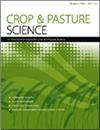野生型大豆与过表达GmWRI1a系种子营养成分的比较分析
IF 1.9
4区 农林科学
Q2 AGRICULTURE, MULTIDISCIPLINARY
引用次数: 0
摘要
摘要上下文。随着转基因大豆(Glycine max(L.)Merr.)的广泛使用,它们对人类食品和动物饲料的营养评价是安全性评价的一个重要方面。WRINKLED1(WRI1)是参与脂肪酸合成的基因的转录激活剂。目标。我们旨在评估GmWRI1a在大豆中过表达对大豆种子营养状况的影响。方法。利用分子生物学技术,我们鉴定了三个稳定过表达GmWRI1a的转基因大豆品系。我们对GmWRI1a-OE和野生型(DN50)大豆种子中的营养成分和抗营养成分进行了定量,并根据实质等效原则对它们进行了比较。关键成果。GmWRI1a和Bar基因在三个GmWRIa-OE系中稳定遗传,转基因大豆种子中的GmWRI1a蛋白含量高于野生型种子。GmWRI1a的过表达导致种子中脂肪酸组成的变化、油含量的显著增加和水苏糖含量的显著降低。野生型和GmWRI1a-OE系种子中其他营养成分(接近物、氨基酸和异黄酮)和抗营养因子(植酸、胰蛋白酶抑制剂和棉子糖)的含量没有显著差异。结论。GmWRI1a-OE种子的营养成分和抗营养成分的含量均在市售大豆的参考范围内,因此与野生型种子的含量基本相当。含义。GmWRI1aOE大豆种子是为注重健康的消费者提供的优质产品。本文章由计算机程序翻译,如有差异,请以英文原文为准。
Comparative analysis of nutritional composition of seeds of wild-type soybean and lines overexpressing GmWRI1a
ABSTRACT Context. With the widespread use of transgenic soybeans (Glycine max (L. ) Merr.), their nutritional assessment for human food and animal feed is an important aspect of safety evaluation. WRINKLED 1 (WRI1) is a transcriptional activator of genes involved in fatty acid synthesis. Aims. We aimed to evaluate the effect of overexpression of GmWRI1a in soybean on the nutritional profile of soybean seeds. Methods. Using molecular biology techniques, we identified three transgenic soybean lines stably overexpressing GmWRI1a (GmWRI1a-OE). We quantified the nutritional and anti-nutritional components in seeds of GmWRI1a-OE and wild-type (DN50) soybean, and compared them on the basis of the principle of substantial equivalence. Key results. The GmWRI1a and Bar genes were stably inherited in the three GmWRI1a-OE lines, and GmWRI1a protein content was higher in transgenic soybean seeds than in wild-type seeds. Overexpression of GmWRI1a resulted in changes in fatty acid composition, a significant increase in oil content, and a significant decrease in stachyose content in seeds. Contents of other nutritional components (proximates, amino acids and isoflavones) and anti-nutritional factors (phytic acid, trypsin inhibitors and raffinose) in seeds were not significantly different between the wild-type and GmWRI1a-OE lines. Conclusions. Contents of nutritional and anti-nutritional components of GmWRI1a-OE seeds were all within the reference ranges reported for commercially available soybeans and, therefore, are substantially equivalent to those of wild-type seeds. Implications. GmWRI1a-OE soybean seeds are a high-quality product for health-conscious consumers.
求助全文
通过发布文献求助,成功后即可免费获取论文全文。
去求助
来源期刊

Crop & Pasture Science
AGRICULTURE, MULTIDISCIPLINARY-
CiteScore
4.20
自引率
15.80%
发文量
111
审稿时长
3 months
期刊介绍:
Crop and Pasture Science (formerly known as Australian Journal of Agricultural Research) is an international journal publishing outcomes of strategic research in crop and pasture sciences and the sustainability of farming systems. The primary focus is broad-scale cereals, grain legumes, oilseeds and pastures. Articles are encouraged that advance understanding in plant-based agricultural systems through the use of well-defined and original aims designed to test a hypothesis, innovative and rigorous experimental design, and strong interpretation. The journal embraces experimental approaches from molecular level to whole systems, and the research must present novel findings and progress the science of agriculture.
Crop and Pasture Science is read by agricultural scientists and plant biologists, industry, administrators, policy-makers, and others with an interest in the challenges and opportunities facing world agricultural production.
Crop and Pasture Science is published with the endorsement of the Commonwealth Scientific and Industrial Research Organisation (CSIRO) and the Australian Academy of Science.
 求助内容:
求助内容: 应助结果提醒方式:
应助结果提醒方式:


